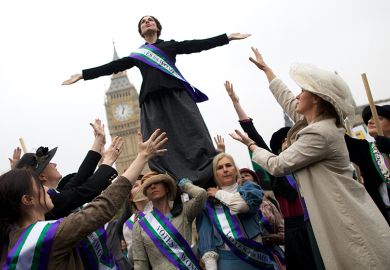The ten subjects of this highly readable book, all of them royal, and most of them learned, would undoubtedly have regarded themselves as ladies. We are not in the realms of feminism here. Rather, Donald Nicol's latest offering falls, like his last, The Immortal Emperor, 1992), into the somewhat neglected genre of the short and elegant historical essay.
In the earlier book he traced the fascinating story of the persistent refusal, even until the present century, to accept that Constantine XI Palaeologus, the last Byzantine emperor, had really perished in the capture of Constantinople by Mehmet II in 1453. Here he follows in an older tradition, represented by Charles Diehl, Figures Byzantines and Imperatrices de Byzance (and much more recently by Dimitri Obolensky's Six Byzantine Portraits, 1988).
The ten are high-born women, whose family connections embrace not only the late Byzantine aristocracy but also the aristocracies of Sicily, Lombardy and Castile, Savoy, Serbia and Trebizond. Through birth and marriage they were in contact with courts and governments. Some outlived the fall of Constantinople, such as Anna Notaras Palaeologina, eldest daughter of a Byzantine grandee in the Peloponnese, whose death at the hands of the Turks alongside his wife and his male children gave rise to several dramatic accounts.
A lifelong spinster, Anna ended her days an exile in Venice and patroness of the growing Greek community there; her name and her patronage are recorded in the fine printed edition of the Greek Etymologicum Magnum produced by Zacharias Kalliergis in Venice in 1499. Nicol speculates on the various forms which this patronage took, Anna herself being too modest to give the details; her will, made in 1493, still exists in the Venetian archives.
Another of the ten, the last Empress of Trebizond, Helena Cantacuzene Komnene (the late Byzantines were much given to grandiose names and titles), dressed in sackcloth and camped outside the walls of her city, where her husband and sons and their male relatives had been executed by the Turks in 1463; like Antigone, she wanted to bury each body with her own hands.
Noble birth in these circles often enough brought tragedy. The ladies who are Nicol's subjects also shared a love of learning and religion. Theodora Raoulina, by birth a Cantacuzene and doubly widowed, spent the latter part of her life in scholarly pursuits in her monastery of St Andrew in Krisei; a friend of Maximus Planudes and a collector of Greek manuscripts who maintained a scriptorium of her own, she was also a particular friend of the patriarch Gregory of Cyprus and had earlier been imprisoned together with her mother for their resolute opposition to Orthodox union with Rome.
The late Byzantine world of these ladies was not only learned but also cosmopolitan; it already interacted with the world of Renaissance humanism.
Though still bound by the aristocratic conventions of marriage alliances and court intrigues, the Orthodox loyalties that led many of them into the religious life did not cut them off from patronage, friendship or learning. Most of their contacts in these learned activities were with men, including leading scholars and writers, among whom they could and did exercise a real influence.
Though parcelled off as brides, and left as widows in difficult circumstances, they were nevertheless luckier than their male relatives, whose fate was often swift and brutal; for these women, life after marriage could be more fulfilling and permit more personal autonomy than life within it. There is food for thought for feminists in this elegant volume, even if its author does not choose to point it out himself.
Averil Cameron is a Byzantine historian and warden of Keble College, Oxford.
The Byzantine Lady:: Ten Portraits 1250-1500
Author - Donald M. Nicol
ISBN - 0 521 45531 6
Publisher - Cambridge University Press
Price - £19.95
Pages - 143pp
Register to continue
Why register?
- Registration is free and only takes a moment
- Once registered, you can read 3 articles a month
- Sign up for our newsletter
Subscribe
Or subscribe for unlimited access to:
- Unlimited access to news, views, insights & reviews
- Digital editions
- Digital access to THE’s university and college rankings analysis
Already registered or a current subscriber?



